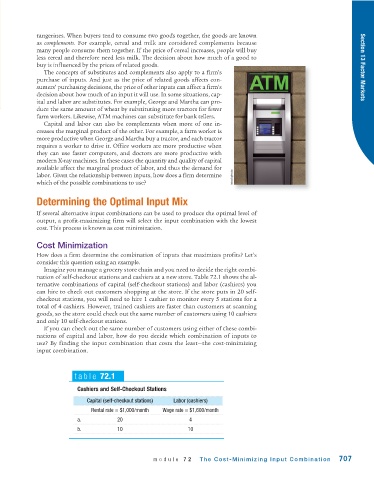Page 749 - Krugmans Economics for AP Text Book_Neat
P. 749
tangerines. When buyers tend to consume two goods together, the goods are known
as complements. For example, cereal and milk are considered complements because
many people consume them together. If the price of cereal increases, people will buy
less cereal and therefore need less milk. The decision about how much of a good to
buy is influenced by the prices of related goods. Section 13 Factor Markets
The concepts of substitutes and complements also apply to a firm’s
purchase of inputs. And just as the price of related goods affects con-
sumers’ purchasing decisions, the price of other inputs can affect a firm’s
decision about how much of an input it will use. In some situations, cap-
ital and labor are substitutes. For example, George and Martha can pro-
duce the same amount of wheat by substituting more tractors for fewer
farm workers. Likewise, ATM machines can substitute for bank tellers.
Capital and labor can also be complements when more of one in-
creases the marginal product of the other. For example, a farm worker is
more productive when George and Martha buy a tractor, and each tractor
requires a worker to drive it. Office workers are more productive when
they can use faster computers, and doctors are more productive with
modern X-ray machines. In these cases the quantity and quality of capital
available affect the marginal product of labor, and thus the demand for
labor. Given the relationship between inputs, how does a firm determine istockphoto
which of the possible combinations to use?
Determining the Optimal Input Mix
If several alternative input combinations can be used to produce the optimal level of
output, a profit-maximizing firm will select the input combination with the lowest
cost. This process is known as cost minimization.
Cost Minimization
How does a firm determine the combination of inputs that maximizes profits? Let’s
consider this question using an example.
Imagine you manage a grocery store chain and you need to decide the right combi-
nation of self-checkout stations and cashiers at a new store. Table 72.1 shows the al-
ternative combinations of capital (self-checkout stations) and labor (cashiers) you
can hire to check out customers shopping at the store. If the store puts in 20 self-
checkout stations, you will need to hire 1 cashier to monitor every 5 stations for a
total of 4 cashiers. However, trained cashiers are faster than customers at scanning
goods, so the store could check out the same number of customers using 10 cashiers
and only 10 self-checkout stations.
If you can check out the same number of customers using either of these combi-
nations of capital and labor, how do you decide which combination of inputs to
use? By finding the input combination that costs the least—the cost-minimizing
input combination.
table 72.1
Cashiers and Self-Checkout Stations
Capital (self-checkout stations) Labor (cashiers)
Rental rate = $1,000/month Wage rate = $1,600/month
a. 20 4
b. 10 10
module 72 The Cost-Minimizing Input Combination 707

